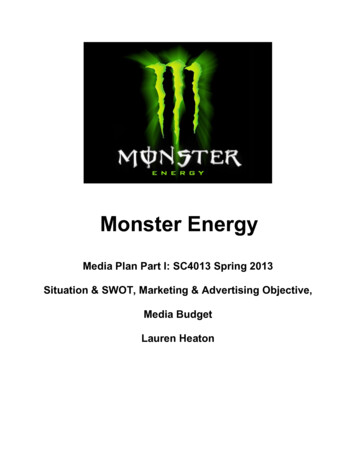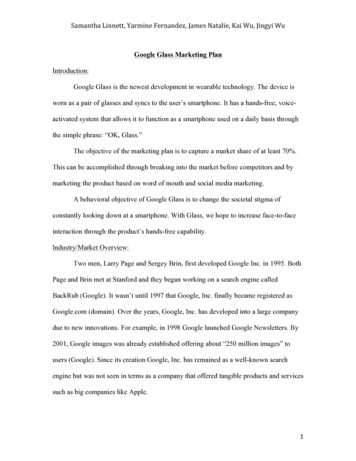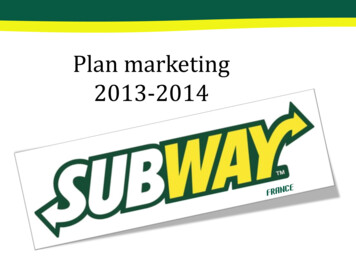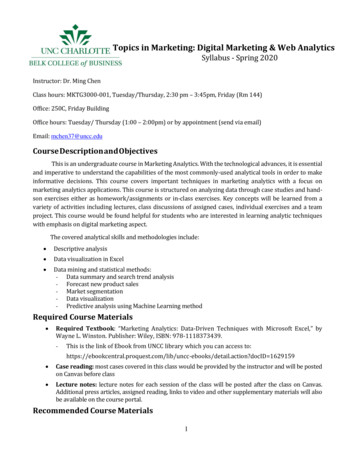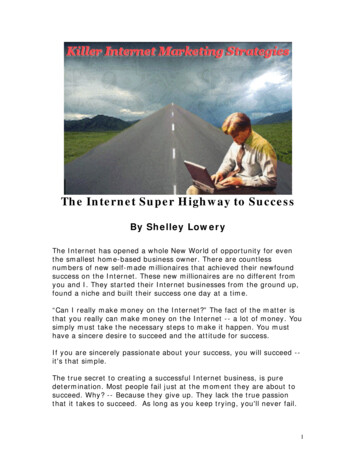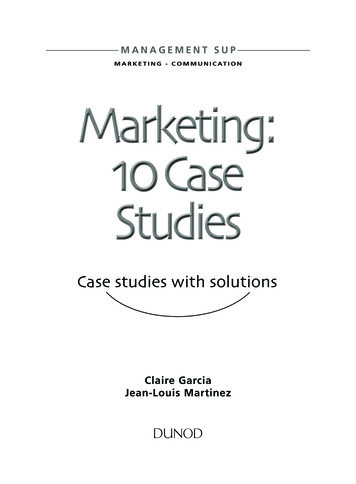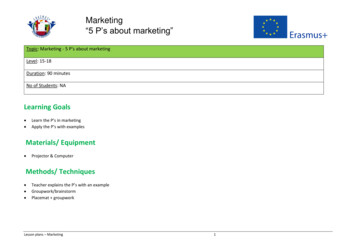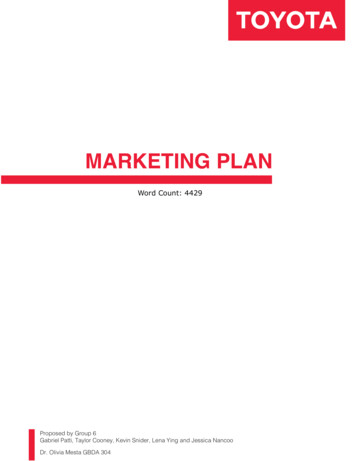
Transcription
MARKETING PLANWord Count: 4429Proposed by Group 6Gabriel Patti, Taylor Cooney, Kevin Snider, Lena Ying and Jessica NancooDr. Olivia Mesta GBDA 304
TABLE OF CONTENTSEXECUTIVE SUMMARY . 1COMPANY DESCRIPTION . 1STRATEGIC PLAN/FOCUS . 2SITUATION ANALYSISIndustry Analysis .Competitor Analysis .Customer Analysis .SWOT Analysis .2445MARKETING OBJECTIVESMarket Penetration .Target Markets .Points of Difference .Positioning .1667MARKETING STRATEGIESProduct Strategy . 8Pricing Strategy . 9Promotion Strategy . 9Place/Distribution Strategy .10SALES FORECAST . 10NOTES . 11EXHIBITS . 13WORKS CITED . 19
EXECUTIVE SUMMARYThe following marketing plan outlines the history, strategy, and objectives for Toyota Kirloskar MotorCorporation, an Indian subsidiary of Toyota recently established to take advantage of an emergingmarket untapped by their largest global competitors: GM and Volkswagen.Toyota Kirloskar has decided to introduce a new, affordable family hatchback specifically designed forIndia’s rough rural terrain: the Yātrā. Toyota aims to combine spectacular safety features, unmatchedcomfort, and innovative technology to offer rural Indians (a price-sensitive, low-income demographic)an incredible car at a low price.By using a combination of pull strategies to reach their primary target market Toyota will motivate consumers to seek out and purchase the Yātrā. Print advertising (magazine spreads), mass media promotion (TV publicity), and social media (active Twitter accounts) will engage buyers in an active processthat successfully informs and persuades Indians to consider Toyota’s newest family hatchback a staplefor rural life. These strategies will be crucial to the Yātrā’s success in the Indian marketplace.COMPANY DESCRIPTIONThe Toyota Motor Corporation is a Japanese automotive manufacturer founded by Kiichiro Toyodaheadquartered in Toyota, Aichi Prefecture, Japan. In 2012, the multinational corporation was[1][2]declared the leading automaker by production, being the first to produce 10 million vehicles per year. Toyota has also been recently recognized as the fourteenth-largest company in the world by reve-[3]nue in November 2014.[4]In the corporation’s lifespan, Toyota has become a well-known brand worldwide through a large focuson global expansion. Today, Toyota products are sold in 170 countries and as exports continue to grow,the localization of production bases has become more significant. Acting on the policy of producingvehicles where the demand exists, the corporation now has 51 bases in 26 different countries andregions in North America, Europe, and Asia.[5]Toyota Kirloskar Motor Private Limited is a subsidiary for the manufacturing and sales of Toyota cars inIndia, located in Bangalore. It is currently the 4th largest carmaker in the country, following Maruti[6]Suzuki, Hyundai, and Mahindra. The Etios models were designed as Toyota’s first Indian-specific vehicles. The sedan model was released in 2010, followed by the Liva hatchback, with both models becoming a large contributor to sales of Toyota vehicles in India. In the first two months of the 2011 fiscal,Toyota Kirloskar sold over 8,000 units of the Etios sedan in the domestic market. The company is[7]competing with approximately thirteen other 'B' segment products from rivals of the Indian car market.[8]Toyota’s commitment to delivering value through world-class vehicles is shown through the globalrecognition of the Toyota brand. In focusing efforts with localization, Toyota Kirloskar is ambitiously1
planning to build a second plant at the Bangalore site. This development would increase the localization level of Etios and Liva from 70 to 90 percent [9]. With the subsidiary’s belief in sustainable development and objective to boost local industries, Toyota Kirloskar hopes to become the country’s top automaker. The expansion provides an opportunity for growth and could make Toyota the most widely[10]trusted brand for automobiles in India.STRATEGIC PLAN/FOCUSToyota’s Global VisionToyota aims to be an industry leader, enriching customers’ lives through innovative products thatutilize advanced technologies and services. Through a commitment to quality, constant innovation andrespect for the planet, we will exceed expectations in the Indian auto industry and contribute to thenation’s economy. We will meet challenges by engaging the talent and passion of all people who believethere is always a better way.Mission StatementToyota will cultivate a customer relationship by providing products and services of superior quality ata competitive price. We strive to create an eco-friendly company in harmony with nature and society.Goals Non-Financial GoalsIt is recommended that Toyota Kirloskar targets India to achieve a 5% growth of global sales in the carmarket. Toyota Kirloskar is encouraged to diversify its advertising and marketing efforts towardstraditional media (magazines, TV ads), new media (social media), and TV publicity which allplay a major role in the consumer decision-making process.Goals Financial GoalsIt is suggested that Toyota Kirloskar increase unit sales of the Etios from 50,000 in March 2012 to60,000 units in 2015, a 20% increase.Toyota Kirloskar should strive to establish production and supplystructures to realize optimum product pricing and delivery.Toyota Kirloskar must increase their Indiansales by 10% after sales in 2013 fell by 22%.Core Competency and Sustainable Competitive AdvantageToyota’s core competency is its ability to produce high-quality vehicles at affordable prices. This ismade possible by the company’s innovative production practices known as the Toyota ProductionSystem (TPS). TPS is based on the Lean Manufacturing concept, which includes innovative practiceslike Just-in-Time, Kaizen, and Six-Sigma; this will be further explained in the SWOT analysis section.Toyota has worked tirelessly to establish this competitive advantage.INDUSTRY ANALYSISThe automotive manufacturing industry is thriving and growing at a quicker rate than ever before. By2
2015, it is predicted to grow 4.5% annually, and Toyota Motor Corporation is leading this trend. By[11]2010, Toyota had opened 66 plants worldwide - 15 in Japan, and 51 others spread across 26 differentnationsresults. Their average annual growth rate has reached 8.31%, “16.44% above the prior year’s[12].” In 2012, the company manufactured 74 different models[13][14]and 9.75 million cars. In[15]this fast paced environment crowded with new competitors, mass production is strategically imperativeto staying successful.As North Americans recover from the tail end of a recession certain trends have become apparent:consumers are no longer purchasing cars. Instead, they are repairing ones they own in an effort tosave money. “ Consumers are holding their cars, on average, for 63.9 months, which is up 4.5 monthsfrom the previous year.” Toyota takes pride in the longevity of their vehicles. According to their web[16]site, “80% of all Corollas in the last 20 years are still on the road. Dealerships are suffering because[17]of this but repair and maintenance shops are on the rise. Toyota promotes a variety of different repairs.They only use genuine, company- made parts. By bundling excellent service with a 5 year warranty it’sno wonder customer loyalty has increased over the years.[18]As consumers become more aware of their environmental impact the demand for eco-friendly cars hasincreased. Toyota has spearheaded the hybrid movement by designing electric and fuel-efficient carslike the Prius, Camry, and Avalon Hybrid. Due to their dedication to innovation, "The Big Three automakers [Ford, Chrysler, and General Motors] are required to quickly release more energy efficient vehicles to the market”. Toyota is determined to win the race by catering to this new, burgeoning[19]market. They have partnered with one of the leading manufacturers of electrical equipment in NorthAmerica, Leviton, to produce an electric car charging station capable of powering all hybrid Toyotavehicles. New doors have opened in the automotive industry, forever changing what is possible.[20]North American Automotive MarketCompetition has always been intense between the United State’s three major manufacturing companies: Ford, Chrysler, and General Motors. However, Japan has begun taking over the North Americanmarketplace. In 2008, Toyota surpassed General Motors in global sales, reaching “2.41 million vehiclesworldwide between January and March [in 2008], compared to GM’s 2.25 million.”[21]The Global Automotive MarketGlobally, there are two countries that have become highly competitive in the automotive market. Germany has three major car manufacturers; Volkswagen, Daimler AG, and BMW; Japan has Toyota,Nissan and Honda. These two nations have been extremely successful in reaching the North Americamarket, threatening to substitute large American brands. Toyota proudly advertises their wide selection of fuel efficient cars to battle competitors such as Volkswagen's new Hybrid Jetta. This is illus-[22]trated by Porter’ Five Forces in figure 2 in the Exhibits.3
COMPETITOR ANALYSISToyota Motor Corporation competes in an oligopolistic auto market where manufacturers are constantly looking to build higher-quality cars. Due to operational costs, new firms suffer from a high barrier toentry. This limits the number of automotive manufacturers in the market. Toyota has a considerableinterest in improving their processes to stay competitive and restrict the number of emerging companies.Many of today’s consumers are part of the ‘green’ movement and have a positive attitude towardsenvironmental sustainability. This, in combination with skyrocketing fuel prices, has created a demandfor smaller, fuel-efficient cars[23].Toyota must maintain a firm grasp on both cost-conscious and envi-ronmentally conscious consumers especially as other manufacturers begin focusing on this section ofthe market.In developed markets, automobile demand is tied to an increasing number of factors like material andmanufacturing costs. Over the past five years manufacturers and consumers have been plagued withhigh gas and oil prices, encouraging the adoption of fuel-efficient vehicles. In an era of modern technology, consumers have become better informed about vehicles’ actual costs; they are less likely toaccept manufacturers’ large annual price increases. Automakers like Toyota must focus on productinnovation, effective cost control and forecasting to determine expenditure and maintain a competitiveedge.One facet of Toyota’s efforts to address the growing cost conscious market is the introduction of newelectric models. While some automakers were more reluctant to shift production efforts to smaller[24]cars, Toyota recognized that an upward trend in fuel prices would influence the demand for types ofvehicles. They understood that consumers would be willing to invest more in upfront costs if it meantpotential savings down the road.With an increase in the number of automobile financing companies in emerging markets, Toyota’sestablishment of export markets is a key success factor to help negate any downturns in domesticmarkets. For example, Japanese carmakers offering fuel-efficient vehicles took market share frommanufacturers of large vehicles over the past five years (Toyota 10.2% overall). Over the next fiveyears, the emerging markets will continue to grow and vehicle sales in the developed world will recover. Toyota has been enhancing its emerging markets business strategy to tap into these opportunities[25]and benefit from a growing consumer demand for fuel-efficient vehicles.[26]CUSTOMER ANALYSISWho Are Toyota’s Customers?Toyota’s global expansion has given the Japanese brand a wide demographic of customers. The company has successfully identified and capitalized on its target markets for 50 years in the Canadian4
marketplacein figure 4. Out of all countries, the United States leads with the highest amount of sales as seen[27]. Toyota caters to individuals and families of high and middle-class income looking for[28]affordable, safe, and innovative vehicles. Average consumers are attracted to the brand’s[29]high-quality, functional designs. Wealthier buyers with a keen eye for luxury, performance, andadvanced technology can also choose from a variety of models. Most recently, Toyota has extended itsline of hybrid, electric, and fuel cell eco-friendly cars to environmentally conscious consum
like Just-in-Time, Kaizen, and Six-Sigma; this will be further explained in the SWOT analysis section. Toyota has worked tirelessly to establish this competitive advantage. INDUSTRY ANALYSIS The automotive manufacturing industry is thriving and growing at a quicker rate than ever before. By. 3 2015, it is predicted to grow 4.5% annually, and Toyota Motor Corporation is leading this trend [11 .

